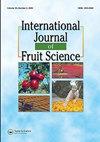Microelements Changes in Leaves and Fruits of Raspberry (Rubus idaeus L.) Under the Influence of Ameliorative Measures
IF 2.4
3区 农林科学
Q2 HORTICULTURE
引用次数: 2
Abstract
ABSTRACT The study evaluated the effects of lime and dolomite application (2 and 4 t ha−1) in combination with NPK fertilizer (1 t ha−1) or borax (50 kg ha−1) on micronutrient concentrations in the raspberry leaves and fruits grown in the soil with a strongly acid reaction. Changes in the content of micronutrients (Fe, Mn, Cu, Zn, and B) and Al in the soil and raspberry leaves and fruits were monitored during a two-year period. Calcification reduced the content of micronutrients and Al in the soil, as well as their content in the plant. Applied doses of lime or dolomite of 4 t ha−1 almost completely neutralized the high to toxic content of mobile Al in the soil, but the values in the leaves although reduced were still high. In all applied treatments, high and very high concentrations of available forms of Fe and Mn in the soil and/or leaves and fruits were significantly reduced. However, the Mn concentrations in the soil, leaves, and raspberry fruits were very high. Calcification did not reduce the available Cu in the soil, while this effect was observed in raspberry leaves and fruits where the Cu concentrations were within optimal values. After calcification, the Zn and B concentrations decreased in the soil and plant, but they mostly remained within the optimal values. The results indicate that due to the very high concentrations of Al and Mn in the soil and plant after lime application, additional doses of lime materials in more than one season are required.覆盆子叶片和果实中微量元素的变化在改良措施的影响下
本研究评价了石灰和白云石(2和4 t ha - 1)配施氮磷钾(1 t ha - 1)或硼砂(50 kg ha - 1)对强酸性土壤中生长的覆盆子叶片和果实中微量元素浓度的影响。对土壤、覆盆子叶片和果实中微量元素(铁、锰、铜、锌和B)和铝含量的变化进行了为期两年的监测。钙化降低了土壤中微量元素和铝的含量,也降低了植物中微量元素和铝的含量。石灰或白云石的施用剂量为4 t ha - 1,几乎完全中和了土壤中高到有毒含量的流动铝,但叶片中的值虽然减少了,但仍然很高。在所有施用的处理中,土壤和/或叶片和果实中高浓度和极高浓度的有效态铁和锰显著减少。然而,土壤、树叶和覆盆子果实中的锰含量非常高。钙化不降低土壤中有效铜,而在铜浓度处于最佳值范围内的覆盆子叶和果实中观察到这种影响。钙化后,土壤和植物中Zn和B的浓度有所下降,但基本保持在最优值范围内。结果表明,石灰施用后,由于土壤和植物中Al和Mn的浓度非常高,需要在多个季节中增加石灰材料的剂量。
本文章由计算机程序翻译,如有差异,请以英文原文为准。
求助全文
约1分钟内获得全文
求助全文
来源期刊

International Journal of Fruit Science
Agricultural and Biological Sciences-Agronomy and Crop Science
CiteScore
6.40
自引率
0.00%
发文量
64
审稿时长
10 weeks
期刊介绍:
The International Journal of Fruit Science disseminates results of current research that are immediately applicable to the grower, extension agent, and educator in a useful, legitimate, and scientific format. The focus of the journal is on new technologies and innovative approaches to the management and marketing of all types of fruits. It provides practical and fundamental information necessary for the superior growth and quality of fruit crops.
This journal examines fruit growing from a wide range of aspects, including:
-genetics and breeding
-pruning and training
-entomology, plant pathology, and weed science
-physiology and cultural practices
-marketing and economics
-fruit production, harvesting, and postharvest
 求助内容:
求助内容: 应助结果提醒方式:
应助结果提醒方式:


